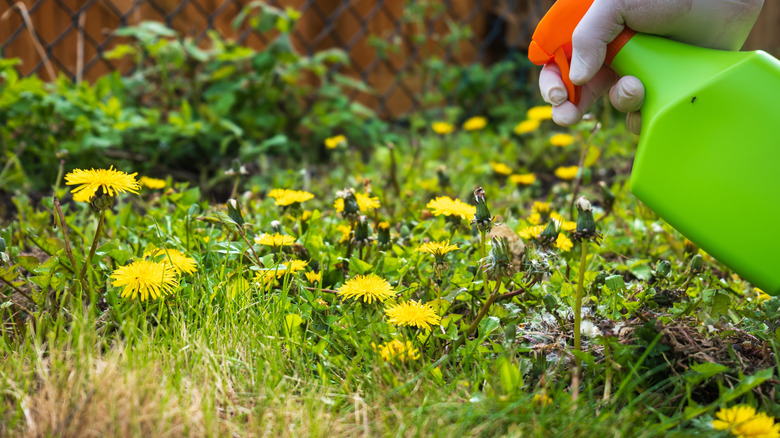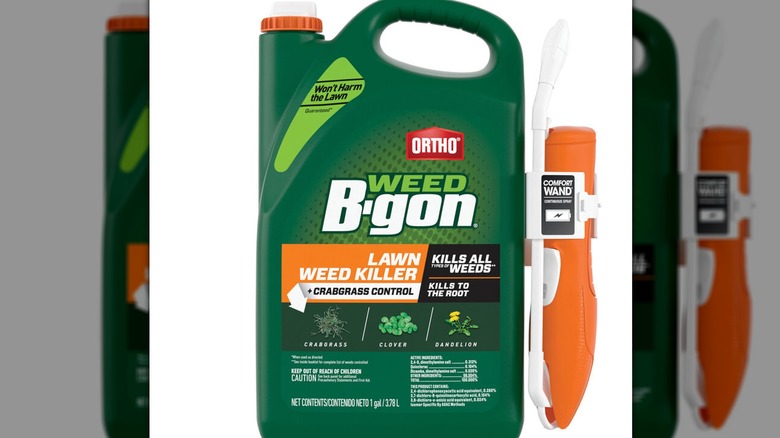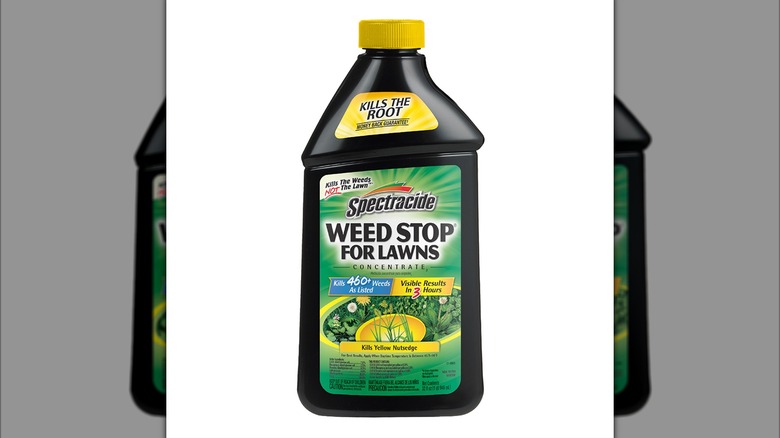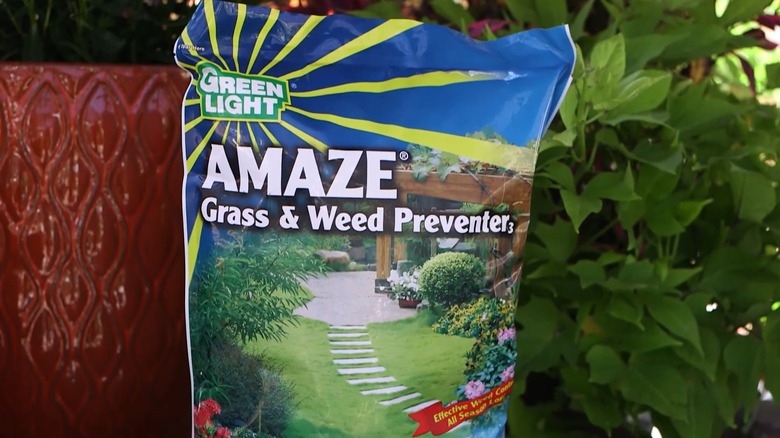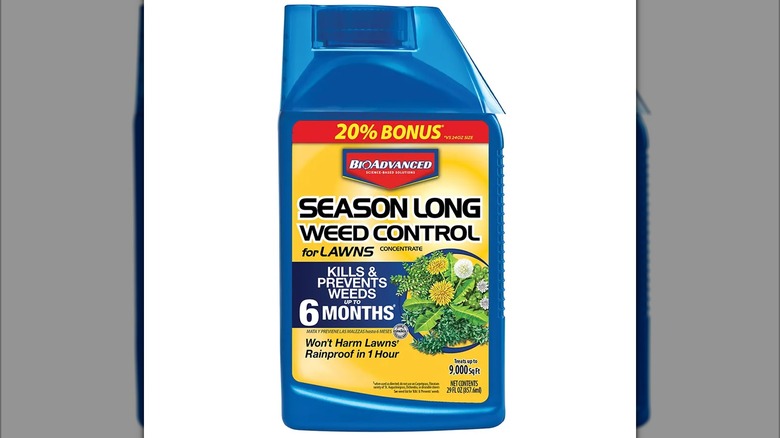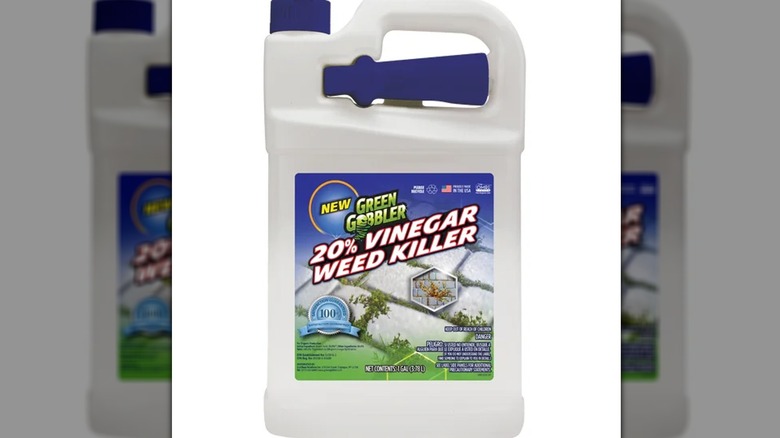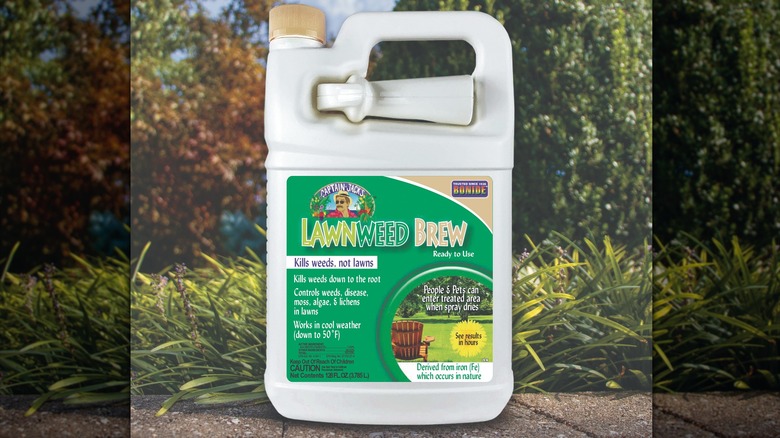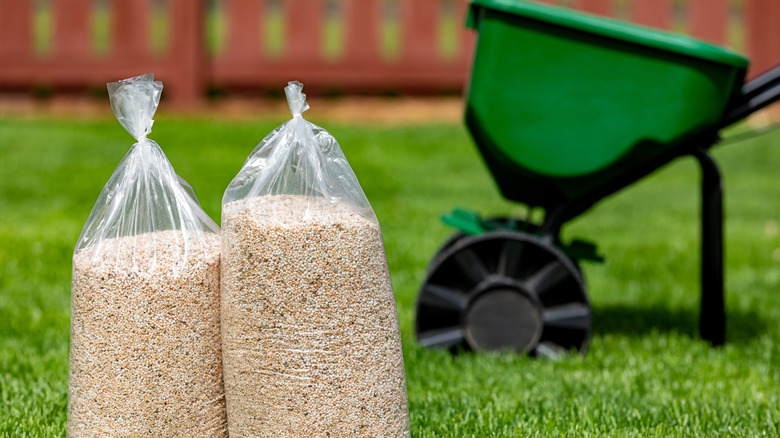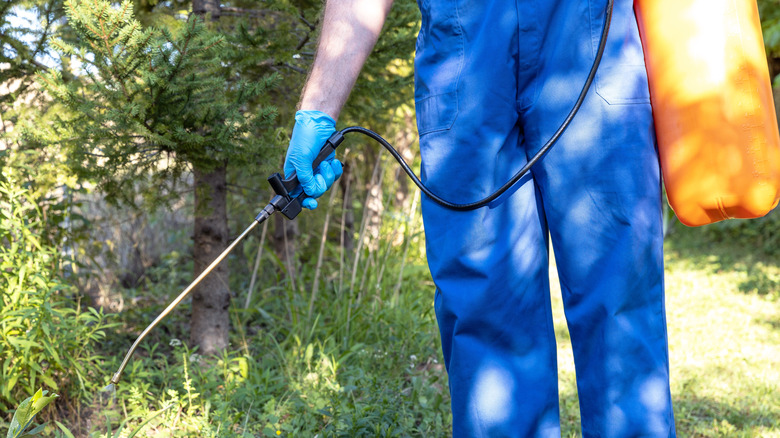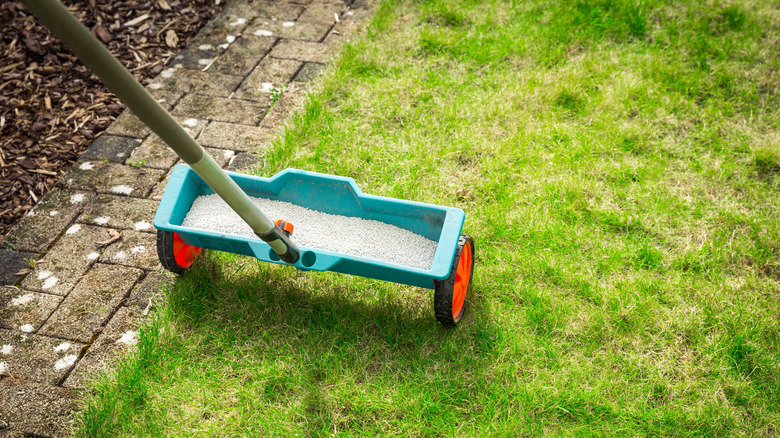The Top 9 Worst Weed Control Products For Your Lawn (& Better Alternatives To Try)
We may receive a commission on purchases made from links.
Dandelion, black medic, nutsedge, poison ivy ... there's no end to the different types of weeds that grow on a lawn. You can try to maintain a healthy turf, pull them out every chance you get, and even scald them to work off the fiery rage invoked by their persistence, but sometimes it's just not enough. Under such circumstances, your best option might be to drive to the garden store and hunt for the magical herbicide that will finally win you the competitive, long-drawn-out war against lawn weeds. Alas, the search for the right weed killer is a battle on its own.
The EPA tests weed control products lining the pesticide shelf for their use-case scenarios, potential pitfalls, and safety. But, the products don't always render the promised long-lasting benefits, and they may even cause frustrating damage (scorched turf, anyone?). That's why House Digest sought the expertise of lawn care professionals with years of practical experience and knowledge under their belt. They told us exclusively about the weed control products that are best left on the store shelves and discussed suitable alternatives. Here is what to avoid if you want the best results.
Weed B-Gon doesn't make dandelions and clover go away for long
Ortho's Weed B-Gon is a selective herbicide, meaning it's formulated to shrivel broadleaf weeds but leave the turf unscathed. It claims to kill over 250 tenacious weeds within hours, including dandelions, morning glory, horsetail, and spotted spurge. However, GreenPal CEO Bryan Clayton exclusively told House Digest, "Now, [Weed B-Gon] claims to handle a wide variety of weeds, but in my experience, it struggles with tougher weeds like clover and dandelions. You might see some results at first, but they come right back, especially in dense patches." In short, while it might work for easier or freshly-established weeds, it won't give you the results you're looking for more aggressive or established varieties.
So, which weed killer should replace Weed B-Gon in your arsenal? Clayton suggests, "Try Tenacity by Syngenta. This stuff not only knocks out tough broadleaf weeds but also keeps them from germinating again, making it a lot more effective." Registered for use in all U.S. states, Tenacity Herbicide and Weed Control's active ingredient, mesotrione, is ironically a compound derived from another plant, bottlebrush. This compound halts weed growth by hindering the vital photosynthesis process. The product works on common broadleaf and grass weeds, including white clover, dandelions, ground ivy, and crabgrass.
Weed Stop won't help with deep-rooted weeds like plantains or chickweed
When firms label their products as "guaranteed to work or money back," like Spectracide Weed Stop For Lawns Concentrate, you'd think it's potent enough to get rid of weeds in a single swoop. Unfortunately, this isn't always the case. Clayton elaborates, "Weed Stop can work for light-duty, but when you've got deep-rooted weeds like plantains or chickweed, it just doesn't go the distance." Mind you, both of these weeds are listed for treatment on its label, in addition to hundreds of others. "The problem is, it tends to burn the lawn in areas where it's over-applied," he adds, though that's fairly expected when package directions aren't followed strictly. That being said, these instances aren't exactly out of the ordinary since many home gardeners are tempted to increase the dose when facing hard-to-kill weeds, especially during reapplications. Centipedegrass and St. Augustine may be more likely to suffer, as their recommended rates are lower than fescue or bluegrass.
So, which weed control product doesn't roast your turf in the name of weed elimination? "I'd go with Drive XLR8. It's a selective herbicide that's safer for your grass and absolutely nails tough weeds, especially crabgrass. Plus, it acts fast and doesn't scorch the lawn." recommends Clayton. Plus, BASF Drive XLR8 Herbicide is a popular choice that earns high marks from its users. You can even mix in methylated seed oil to further enhance its performance.
Amaze Grass and Weed Preventer does a lackluster job of weed prevention
Cleverly marketed as a product to stop weeds from growing in the first place, Green Light's Amaze Grass and Weed Preventer has garnered quite the attention of homeowners sick of henbit, chickweed, yellow woodsorrel, and other annual grass weeds reemerging come the growth season. It includes chemicals that block the weeds from developing their roots and other plant parts. However, based on his experience, Clayton refutes these claims, explaining, "Amaze Grass and Weed Preventer is more of a pre-emergent, and honestly, it's just weak. It won't prevent weeds from showing up like it claims, especially in high-traffic areas."
Instead, Clayton recommends Quali-Pro's Prodiamine 65 WDG. He notes, "It's a professional-grade pre-emergent that will keep weeds from ever showing up. It has long-lasting effects and covers a wide range of weed types," This includes field bindweed, annual bluegrass, Russian thistle, and crabgrass. Like Green Light's product, this also focuses on restricting root or sucker development, albeit far more successfully. It should be applied in late winter or very early spring, although fall applications are also possible when necessary.
Season Long Weed Control for Lawns only offers a temporary respite
Anybody who's looked for effective ways to kill the Virginia creeper taking over their yard, or any of its equally pernicious weedy associates like creeping Charlie, has likely heard about BioAdvanced's Season Long Weed Control for Lawns concentrate. It is a 2-in-1 formula that behaves as a pre-emergent herbicide, promising to deny weeds any right of way for up to half a year, as well as a post-emergent when applied correctly. However, Clayton mentions, "In my experience, the 'season-long' part just isn't true. You get about a month of relief, and then the weeds come creeping back in. For something you pay a premium for, it's pretty disappointing."
Unsurprisingly, he makes the case for Roundup, not the classic, non-selective glyphosate-based weed killer but the one titled Roundup for Lawns. Instead of glyphosate (that kills any and everything green), Roundup for Lawns contains dicamba, MCPA, sulfentrazone, and quinclorac as active ingredients, which selectively exterminate notorious weeds, including nutsedge and crabgrass. Moreover, "This product actually lasts the full season and is safe for most turf grasses, unlike the traditional Roundup that can kill everything it touches. It's way more reliable for long-term weed control," says Clayton. However, the ingredients in Roundup for Lawns are actually more toxic than its traditional counterpart, making it essential that you follow the label instructions and keep on your protective gear during spraying.
Vinegar-based weed killers aren't helpful with tough perennial weeds like dandelions and crabgrass
Concerns over environmental pollution have encouraged several home gardeners to look for less harmful ways to kill weeds in their lawns. Some opt to use Organic Materials Review Institute (OMRI)-certified weed control products, especially those made of acetic acid or vinegar, in lieu of synthetic herbicides. Green Gobbler with its corn-derived acetic acid is one such product. Ryan Farley, CEO of LawnStarter, advises against using it on your lawn in his exclusive House Digest interview. Farley explains, "You're looking at a temporary solution at best — one that's ineffective against tough perennial weeds like dandelions and crabgrass."
Boise Landscaping Company's Gavin Warwick echoes this opinion telling House Digest, "I'm all for going green, but vinegar-based sprays just don't have the staying power. They knock down weeds initially, but don't get to the root of the problem (literally)." In other words, such sprays behave as contact herbicides, desiccating and killing all visible plant parts, sans the growth underground, which is how weeds get the leeway to make a comeback. For this reason, they're best left to deal with juvenile weeds.
There's still hope though for those wanting a greener approach. "For clients who prefer organic options, I suggest trying Corn Gluten Meal (CGM) as a pre-emergent solution. It doesn't kill existing weeds but stops new ones from sprouting," mentions Warwick. A by-product from corn milling, CGM nips seed germination, notwithstanding whether it's crabgrass, purslane, or lambsquarter, while concurrently enriching the soil with nitrogen. Keep in mind, the results improve after successive applications through the years. The CGM will also stop grass from seeding, so it will impact any overseeding efforts you use to thicken your lawn.
Commercial organic sprays rarely offer tangible results
Vinegar-based products aside, the horticultural trade is saturated with an array of organic weed killers relying on different ingredients to sort the undesirables. But, "they tend to give disappointing results," says Tom Monson, owner of Monson Lawn & Landscaping, in his exclusive House Digest interview. "I've tried to use Captain Jack's organic weed control for customers who want everything organic. It made the weeds sick and wilted, but they came back." This is a shame, considering the iron-based herbicide professes to tackle weeds even if the temperatures dip to 50 degrees Fahrenheit. "I've also tried Earth's Ally and the weeds returned a few days later," Monson continues.
Heroes Lawn Care President, Brad Saunders, also weighed in on green methods explaining, "EcoSmart Natural Weed and Grass Killer is great in terms of being safe for kids and pets, but its performance can be frustratingly slow. You have to apply it several times, especially on tougher, more established weeds, before you start seeing any real results." Saunders explains the poor performance on the sheer nature (and irony) of the product. "The reason for this is that it uses natural ingredients, which don't have the same aggressive action as synthetic chemicals. While that makes it safer for the environment, it also means it doesn't always penetrate deep enough to kill resilient weeds in one go."
So, the consensus is, you may need to opt for something stronger, especially if you're dealing with more stubborn and established weeds. David Miller, arborist and founder of Austin Tree Services, shares, "Glyphosate-based products still might come in handy for tough, deep-rooted weeds, as this systemic herbicide is carried down to the roots after being absorbed into the plant. Sure, it isn't eco-friendly, but using it sparingly and directly on problem areas will give long-lasting results."
Granular pre-emergent products extend patchy coverage
When your turf has a record of being overrun by weeds, taking preventative measures like applying pre-emergent herbicides during spring and fall is often the right call. With their residual activity, they successfully keep most germinating weeds down for around 8 to 12 weeks. In short, long enough for the grasses to get moving. However, picking the right pre-emergent is key, not only in terms of its suitability to the type of grass you have, the air temperatures, and the time of year, but also the form (liquid or granular).
Warwick elaborates, "The cheaper, granular forms can be tricky. They rely on even distribution to be effective, but getting an even spread can be challenging, especially if the applicator isn't calibrated perfectly or if it's applied unevenly due to wind or terrain." This can lead to increased costs later on as patchy coverage means you'll likely need extra treatments.
Instead, Warwick suggests relying on a high-quality liquid pre-emergent to give your lawn some much-needed protection, explaining, "You could switch to a liquid pre-emergent like Quali-Pro Prodiamine 65 WDG. It's around the same price as many granular options but provides more consistent protection across the lawn." But, if you still prefer to use a granular product, Warwick recommends trying a split application method, saying, "Apply half the product initially, followed by the other half a few weeks later."
Avoid glyphosate-based weed killers on broadleaf lawn weeds
In a strange, although not wholly unexpected twist, our professional experts find themselves on opposite ends of the spectrum regarding the use of glyphosate — a non-selective herbicide that restricts protein formation and consequently liquidates most green plants, including weeds. However, reading the finer print helps. Warwick makes his case, "Non-selective herbicides like Glyphosate-based products aren't ideal for lawns with broadleaf weeds. These are heavy-duty and can clear out weeds fast, but also take out your grass if you're not careful." As if dead turf wasn't a reason enough for alarm, it gets worse, or so exemplifies Warwick, "A client of mine used a glyphosate product on dandelions and ended up with large dead spots, which then became overrun with crabgrass." Clearing out existing broadleaf weeds only to invite back their crueler colleagues isn't what lawn owners had in mind while using glyphosate.
But if not glyphosate, then what? Warwick says, "I recommend using 2,4-D or Triclopyr. These selective herbicides target broadleaf weeds without harming the grass." This advice turned out in the clients favor as he explained, "After using 2,4-D, their lawn was dandelion-free within a couple of weeks, and the grass filled in beautifully, eliminating the need for reseeding."
Weed and Feed products are ineffective on both fronts
In the name of ease and convenience, lawn care companies have taken to combining pre-emergent herbicides with granular fertilizers, birthing the concept of Weed and Feed products. "While the idea of a one-two punch with weed control and fertilization sounds great, in practice, these products often fall short. That's because the timing for fertilizing and killing weeds doesn't always align, leading to suboptimal results for both tasks," explains Warwick.
Simply put, in most lawns, especially warm-season grasses, the first pre-emergent application must be carried out when they're still dormant while the fertilization schedule kicks in much later during active growth season — ideally, after at least two rounds of mowing. Fertilizing prematurely stimulates the growth of grassy blades before an adequate root system has fully developed, lowering their resilience to drought stress and diseases. As is known, unhealthy lawns don't translate to weed-free turf. Warwick continues, "Additionally, weed and feed products can distribute the herbicide and fertilizer unevenly. This causes inconsistent weed control and nutrient delivery." Another reason to avoid these weed control products is their limited strength. "They tend to have lower concentrations of herbicide, making them less effective on tough weeds," Warwick explains.
Considering these facts, it's best to sacrifice convenience for the right practices. Warwick recommends, "I've found that treating the weeds first with Ortho's Weed B-Gon and then using a high-quality fertilizer like Milorganite separately yields much better results. This approach allows for precise timing, resulting in a lush, weed-free lawn."
